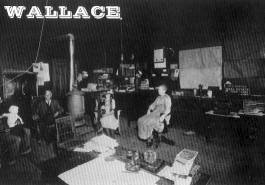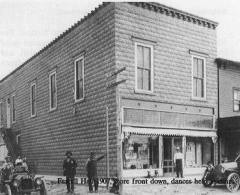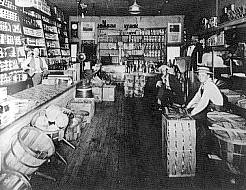
|
Wallace celebrated its centennial throughout 1987, culminating in a big three-day festival, September 18-20. Business leaders, organizations, and individuals held smaller events during the year, with the annual one-day fall festival on the second Saturday in September expanded to include special activities -- all to remember life as it had been during the past century. Wallace hasn't always been located where it is today. For a while it was half a mile south. The site was called "Kain's Corner" on property owned by William and Mary Kain. Their grandson, Aaron Kain and his wife Lois, still live in Wallace. The town got its name, according to old timers, because of the leadership of Frank Wallace, who was a homesteader living south of town. He was instrumental in organizing a school. [Other sources credit the name to that of the son or son-in-law of an official with the land office or railroad.] When the railroad was built in 1887, Wallace was platted and moved to its present site. The land company was assisted by Griswald, the president of the company, and P.L. Harper, whose grandson, Fred Evans lives in Wallace. An early resident, Emma Ronk, wrote about the rush of homesteaders to settle. She stated, "a handsome Methodist Episcopal Church with a cupola and bell tower was built in 1888." This church is the oldest building in town and the congregation will celebrate its centennial in September, 1988.
Things started looking up by 1905 when numerous businesses started. The population was up to 300-400 by 1912, according to Ronk. The Catholic church was built in 1909. The "Wallace Herald" was established in 1889 and a second newspaper, the "Wallace Star," in 1891. The Star told of a hotly-contested political election with 267 voters casting ballots. (This included only the male population, since women did not have a vote in those days.) Prairie fires top the list of disasters for Wallace. A devastating prairie fire occurred in 1908, starting four miles south of Ogallala (about 50 miles west of Wallace) it swept across country, causing serious loss to farmers and had come within five miles of Wallace. Dell Raney lost everything but his home and C.M. Hayden lost his barn, three horses and other buildings. Ed Kain, caught in the fire when his horse refused to jump a fence, had his clothing, except for his high top shoes, burned from his body. He managed to get home, but died later that night. According to news reports, only a superhuman effort by residents of Wallace prevented further losses to the town. Another prairie fire in 1919 took everything Grant Phillips had except his wife and children. He lost 85 head of horses, 60 tons of hay, and all his buildings and corn.
The Assembly of God Church was organized in 1932, and a Lutheran church in 1975. The Morning View Cemetery that serves Wallace, located two miles south of town, receives perpetual care from a bequest made by Mrs. Marie Hughes in 1964. An airport, established south of town in 1952, is kept busy with aerial crop spraying. Since Wallace is well-situated over the Ogallala aquifer, the farm community is most fortunate to have a generous supply of water for all who choose to put down a well. There are many center pivots in the area. During the building of the Gerald Gentleman Power Plant south of Sutherland from 1975-79, Wallace was one of the communities that provided housing for workers. The increased population and additional expenditures was a real help to the local economy. The peak population of 406 came in 1930, with the 1980 count at about 350. Wallace, located along Highways 23 and 25, enjoys its rather solitary location and friendly residents, making this a pleasant community in which to live.
By Jean Evans, Wallace, NE 69169 "Emma Rosalie, A Story Out of the Yesterdays." By Emma Rosalie Ronk. |
| Copyright NEGenWeb |
 WALLACE --
LINCOLN COUNTY
WALLACE --
LINCOLN COUNTY "Although
Wallace prospered for a while, hardly anything was
grown during the dry years from 1893-95," Ronk wrote.
Early pioneers who stayed were so destitute that
relief supplies had to be shipped in by concerned
friends and relatives, and seed corn had to be sent to
the area by the government. The population in town
dropped to 42 residents in the early 1900s.
"Although
Wallace prospered for a while, hardly anything was
grown during the dry years from 1893-95," Ronk wrote.
Early pioneers who stayed were so destitute that
relief supplies had to be shipped in by concerned
friends and relatives, and seed corn had to be sent to
the area by the government. The population in town
dropped to 42 residents in the early 1900s. Amie Murray
established the telephone exchange in her home in
1914. The system was later sold and a dial system was
installed in 1959. In 1917 a brick schoolhouse was
built. This was replaced with a larger, modern
building in 1856, and an addition in 1975. A community
hall, a gift from friends in memory of J.R. Johnson of
Pittsburgh, PA., was built in 1921. (Johnson and his
friends had spent considerable time in Wallace hunting
and enjoying local friendships.)
Amie Murray
established the telephone exchange in her home in
1914. The system was later sold and a dial system was
installed in 1959. In 1917 a brick schoolhouse was
built. This was replaced with a larger, modern
building in 1856, and an addition in 1975. A community
hall, a gift from friends in memory of J.R. Johnson of
Pittsburgh, PA., was built in 1921. (Johnson and his
friends had spent considerable time in Wallace hunting
and enjoying local friendships.)